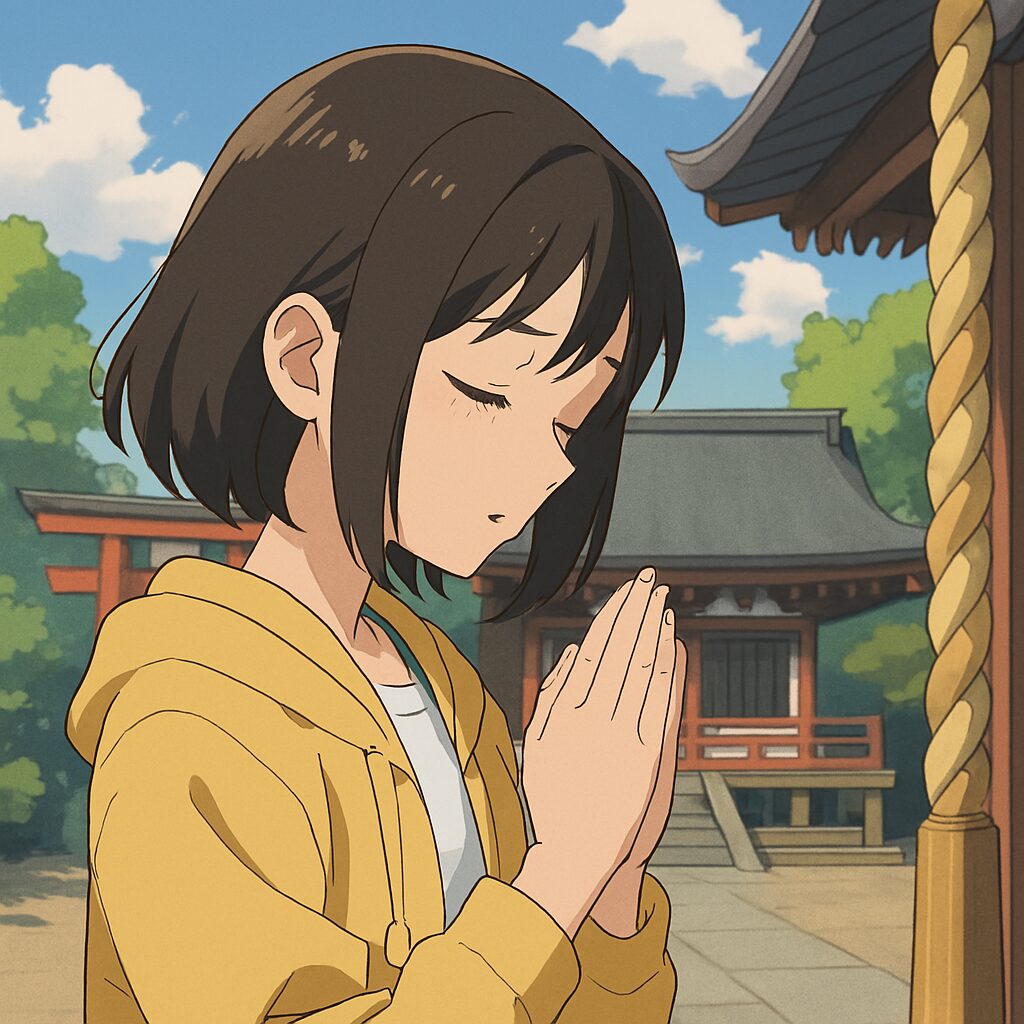Introduction: The Memory Held in Our Hands
If you’ve ever visited Japan, you may have witnessed a quiet, moving gesture: A person walking through a shrine’s torii gate, then pressing their hands together in silence. Before a meal, someone says “Itadakimasu” and gently brings their palms together. At the end of a farewell, an elderly person bows deeply, hands pressed in front of their chest.
This is prayer. This is gratitude. This is respect—expressed not through words, but through the body.
In Japan, emotions often find their first expression in the hands. This gesture transcends religion, age, and social status. It lives quietly in everyday life, connecting people to something deeper.
Chapter 1: At the Shrine — A Silent Bridge Between Human and Divine
At Shinto shrines in Japan, visitors follow a ritual known as “two bows, two claps, one bow.” Within this sequence, the moment of pressing hands together is a bridge—a pause between the self and the divine.
The claps (kashiwade) are a way of calling the gods. The hands pressed together afterward create a space for wishes, reflection, and connection.
This act isn’t enforced by religious doctrine. Rather, it offers a moment of ma—a sacred pause—for the individual to face their own heart. Through this gesture, gratitude and prayer take shape.
For a practical guide to shrine etiquette, see: 👉 🏯 How to Properly Visit a Shinto Shrine: A Guide for Visitors to Japan To explore the deeper meaning of silence and space in Japanese culture, read: 👉 🧘♂️ The Aesthetics of Silence: How “Rei” and “Ma” Shape Japan’s Wordless Communication
Chapter 2: In Front of the Buddhist Altar — A Dialogue with the Departed
In many Japanese homes, people press their hands together in front of a Buddhist altar. It’s not just a ritual—it’s a conversation with memory.
Even after loved ones pass away, many families continue to greet them each morning. “Please watch over us today.” “Thank you for yesterday.” These unspoken feelings are conveyed through the hands.
This is not just a religious act—it’s an emotional ritual. By pressing hands together, the past and present connect. It’s a way of saying: “Our relationship hasn’t ended. It continues.”
Chapter 3: Before and After Meals — Gratitude for Life Itself
“Itadakimasu.” “Gochisousama deshita.”
These phrases, spoken before and after meals, are accompanied by pressed hands. They express thanks not only to the cook, but to the lives sacrificed for the meal, to nature, and to the act of living itself.
This habit is taught from early childhood, regardless of religious background. It’s a cultural instinct—an acknowledgment that eating is a sacred exchange.
To dive deeper into this beautiful tradition, visit: 👉 The Heart Behind “Itadakimasu” and “Gochisousama”
Chapter 4: Farewell Moments — Respect in Silence
In Japan, farewells sometimes include the gesture of pressing hands together. Especially among elders or those with Buddhist values, this gesture replaces spoken words.
It says: “Thank you.” “It was an honor.” “Please stay well.”
This is respect expressed through silence. By pressing hands together, the relationship is remembered—not as something that ends, but as something that continues.
To understand another key gesture of Japanese respect, explore: 👉 Why Do Japanese People Bow?
Chapter 5: Beyond Religion — A Universal Language of the Body
Though rooted in Buddhism and Shintoism, the act of pressing hands together functions as a universal body language in Japan.
For example, when watching news of a disaster, some people instinctively press their hands together toward the screen. It’s a gesture of empathy, prayer, and solidarity.
It’s also a way of confirming one’s own humanity— A quiet moment to recognize the ability to care, to grieve, to hope.
Conclusion: A Gesture That Holds the Heart
In Japan, hands often speak before words do. This gesture—simple, silent, and profound—holds prayer, gratitude, and connection.
It transcends religion, culture, and time. It’s a tradition passed down not through doctrine, but through feeling.
If you ever visit Japan, Try pressing your hands together in a quiet moment. You may find that something gentle and meaningful reaches your heart.
- Introduction: The Memory Held in Our Hands
- Chapter 1: At the Shrine — A Silent Bridge Between Human and Divine
- Chapter 2: In Front of the Buddhist Altar — A Dialogue with the Departed
- Chapter 3: Before and After Meals — Gratitude for Life Itself
- Chapter 4: Farewell Moments — Respect in Silence
- Chapter 5: Beyond Religion — A Universal Language of the Body
- Conclusion: A Gesture That Holds the Heart
- 🙏 手を合わせるという祈り:日本人の心が宿る所作
🙏 手を合わせるという祈り:日本人の心が宿る所作
はじめに:言葉よりも深い「手の記憶」
あなたが日本を訪れたとき、ある光景に心を奪われたかもしれません。 神社の鳥居をくぐった人が、静かに手を合わせる。 食事の前に「いただきます」と言って、手を合わせる。 別れ際に、深く頭を下げながら手を合わせる。
それは祈りであり、感謝であり、敬意の表現でもあります。 日本人は、言葉にならない想いを「手」に託します。 この習慣は、宗教を超え、世代を超え、日常の中に静かに息づいています。
第1章:神社での手の所作——神と人をつなぐ静かな橋
日本の神社では、参拝の際に「二礼二拍手一礼」という所作があります。 この中で、手を合わせる瞬間は、神と自分をつなぐ「間(ま)」のようなもの。
拍手(かしわで)は、神様への呼びかけ。 その後に手を合わせるのは、願いを届けるための静かな時間。
この行為に、宗教的な強制力はありません。 むしろ、個人の内面と向き合うための「余白」として存在しています。 手を合わせることで、自分の心の中にある願いや感謝が、形になるのです。
神社参拝の作法について詳しく知りたい方は、こちらのガイドもおすすめです: 👉 🏯 How to Properly Visit a Shinto Shrine: A Guide for Visitors to Japan また、「沈黙」や「余白」の美学については、こちらの記事もご覧ください: 👉 🧘♂️ The Aesthetics of Silence: How “Rei” and “Ma” Shape Japan’s Wordless Communication
第2章:仏壇の前で——亡き人との対話
家庭の仏壇の前で手を合わせる。 それは、亡くなった人との対話であり、記憶との再会です。
日本では、祖父母や両親が亡くなった後も、毎朝仏壇に手を合わせる習慣があります。 「今日も無事に過ごせますように」 「昨日はありがとう」 そんな言葉にならない想いを、手に込めて伝えるのです。
この行為は、宗教的儀式というよりも、感情の儀式です。 手を合わせることで、過去と現在がつながり、心が整っていく。 それは、亡き人との関係が「終わらない」ことの証でもあります。
第3章:食事の前後——命への感謝のかたち
「いただきます」 「ごちそうさまでした」
この二つの言葉とともに、日本人は手を合わせます。 それは、料理を作ってくれた人への感謝だけではありません。 食材となった命への感謝、自然への敬意、そして「生きること」への感謝が込められています。
この習慣は、幼稚園や家庭で自然に教えられます。 宗教的な背景がなくても、誰もが手を合わせる。 それは、日本人が「命をいただく」という行為に、深い意味を見出しているからです。
この文化的背景については、こちらの記事でさらに詳しく掘り下げています: 👉 The Heart Behind “Itadakimasu” and “Gochisousama”
第4章:別れの瞬間——沈黙の中の敬意
日本では、別れの挨拶に手を合わせることがあります。 特に高齢者や仏教的な価値観を持つ人々は、別れ際に手を合わせて頭を下げます。
それは「ありがとう」「また会いましょう」「お元気で」という言葉の代わり。 言葉にするには重すぎる感情を、手に託して伝えるのです。
この所作には、沈黙の中の敬意があります。 手を合わせることで、相手との関係が「終わらないもの」として記憶されるのです。
このような身体言語のひとつとして、日本人の「お辞儀」文化も深く関係しています: 👉 Why Do Japanese People Bow?
第5章:宗教を超えた身体言語としての「手」
手を合わせる文化は、仏教や神道に根ざしているように見えますが、 実際には宗教を超えた「身体言語」として機能しています。
例えば、災害のニュースを見たとき、画面に向かって手を合わせる人がいます。 それは祈りであり、共感であり、痛みへの寄り添いです。
手を合わせることは、自分の中の「人間性」を確認する行為でもあります。 それは、誰かのために祈ることができる自分を、そっと見つめる時間なのです。
おわりに:手を合わせるという「心の所作」
日本人は、言葉よりも先に、手を合わせます。 それは、感情が言葉になる前の、もっとも純粋な表現。
この所作には、祈り、感謝、敬意、そして「つながり」が宿っています。 宗教を超え、文化を超え、世代を超えて受け継がれてきたこの習慣は、 日本人の「心のかたち」そのものなのかもしれません。
もしあなたが日本を訪れることがあれば、 ぜひ一度、静かに手を合わせてみてください。 その瞬間、あなたの心にも、何かが静かに届くかもしれません。



コメント